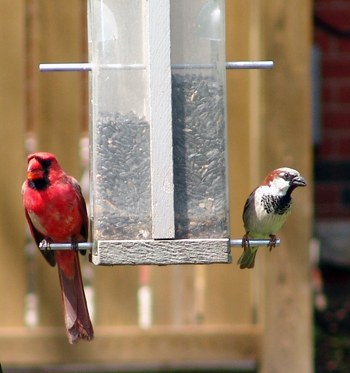Attracting Birds to Your Backyard: Bird Feeder Basics
 Providing birds a food source is an easy way to provide for wildlife viewing opportunities, particularly during the winter.
Providing birds a food source is an easy way to provide for wildlife viewing opportunities, particularly during the winter.
Three items to consider when starting a bird feeding program are
feeder types,
location, and
seed selection.
Selecting a bird feeder
Feeder types include ground or tray feeders, hopper feeders, tube feeders, and suet or basket feeders.
Ground or tray feeders are designed to be set directly on the ground or close to ground level. Low cut tree stumps are good locations for tray feeders. These feeders are simply trays that have seed scattered on the surface. Trays with a lip around the edge help prevent seed from being scratched onto the ground. Use trays that have drain holes to reduce water buildup and reduce chances of mold.
Hopper feeders or self feeders are larger feeders that automatically disseminate seed on to a tray or platform as it is removed by the birds. Hopper feeders keep the seed dry and need to be refilled less often then other feeders.
Tube feeders are lengths of glass or plastic tubing with openings and perches allowing the birds to land and feed.
Suet or basket feeders range from simple onion bags to more elaborate wire cages and are designed to hold suet.
Where to place bird feeders
Locating feeders requires one to consider not only the best viewing areas but also
- protection for the feeding birds,
- ease in refilling and cleaning, and
- the variety of desired bird species.
Predators, both mammalian and avian, will be attracted to feeding sites. Make sure there is escape cover in the form of trees, shrubs, or brush piles within 15 feet of the feeding location. This allows feeding birds a location to fly and hide when predators show up.
In order to attract the widest variety of birds, it is important to locate feeders at different heights. Many birds feed from the ground while others are adept at feeding on raised trays or even on the hanging tube or suet feeders. Establishing a variety of feeders and feeding heights provides the best opportunity for viewing many different species of birds.
Bird seed selection
Seed selection is also a very important component of bird feeding. Black-oil sunflower seed and white proso millet seed are considered two of the better seeds to use when feeding birds. The black-oil sunflower can be used in tube feeders and mixed with the millet in ground and hopper type feeders. This combination of seeds is less apt to attract starlings and grackles then commercial mixes containing other types of seed.
The final thing to keep in mind when considering feeding the birds is your commitment. During the winter months, birds come to depend on you as a steady source of food. Your bird station could be a lifesaver particularly during heavy snow or ice, when natural food sources are buried.
